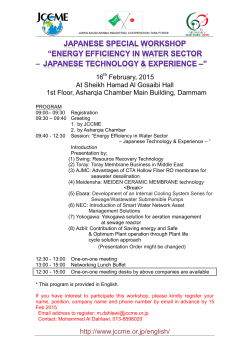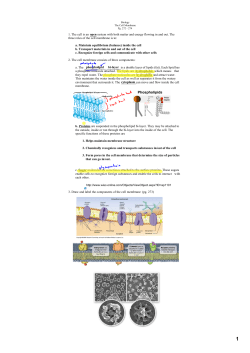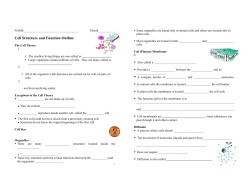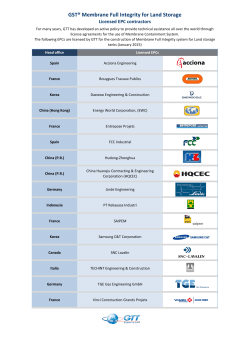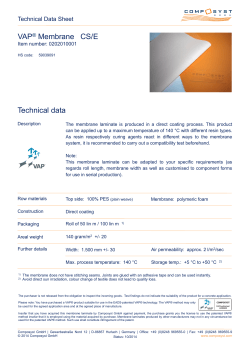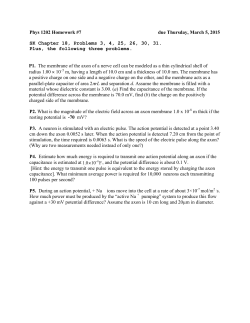
the full press release - Mechanobiology Institute, Singapore
FEATURED RESEARCH Lipid Anchors Sustain Life A role for GPI-anchored proteins in epithelium integrity By Lakshmi Ramachandran, PhD and Andrew Wong, PhD| 25 March 2015 A study from the Mechanobiology Institute (MBI), National University of Singapore, reveals that glycolipids which anchor certain proteins to the cell membrane also play a vital role in stabilizing the membrane, especially against mechanical stress that arises during embryonic growth and development. This work is published in PLoS Genetics (Budirahardja et al., Glycosyl Phosphatidylinositol Anchor Biosynthesis Is Essential for Maintaining Epithelial Integrity during Caenorhabditis elegans Embryogenesis, PLoS Genetics, 25 March 2015, doi: 10.1371/journal.pgen.1005082) Why do embryos that lack GPI-APs die? All living cells have a membrane around them, forming a protective barrier that helps contain the various cellular components and prevent entry of foreign material into the cell. The cell membrane is made of lipids and proteins, contributing to membrane structure and function. Some membrane proteins integrate within or span the lipid bi-layer structure of the membrane, while some associate with the membrane exterior either directly or through addition of a Glycosylphosphatidylinositol (GPI) lipid anchor. It is well known that GPI anchors are critical for the normal growth and development of an embryo. However, the question of how they play a role in embryonic development remains unanswered, as mutants of GPI anchor biosynthesis required to investigate the role of GPI anchors in living organisms typically die at a very early embryonic stage, preventing further studies. Recently, Dr. Yemima Budirahardja and Thang Doan, from the lab of A/Prof. Ronen Zaidel-Bar, MBI, overcame this challenge by using a GPI anchor biosynthesis mutant of the worm Caenorhabditis elegans with a partial loss of function. but one intriguing possibility is that they do it through an indirect connection to the cytoskeleton that lies beneath the membrane. When this connection is disrupted, the cell becomes more susceptible to external forces and mechanical stress. These stresses occur regularly during development, as the embryo divides and reorganizes, or may arise internally, such as intestinal expansion and contraction during digestion. Intriguingly, Budirahardja and colleagues discovered that reinforcing the links between the cytoskeleton and the membrane from within the cell can protect against these mechanical stresses, even in the absence of GPI anchors. This study suggests a basic underlying mechanism for GPI anchor function in maintaining epithelial cell integrity. Minor mutations in GPI anchor biosynthesis have severe consequences in humans, resulting in diseases such as paroxysmal nocturnal hemoglobinuria, where ‘leaky’ red blood cells are attacked by the body’s own immune system, and the congenital disorder Mabry syndrome, which is characterized by intellectual disabilities, and abnormalities in the renal and digestive system. Understanding the role of epithelial integrity in these GPI anchor diseases could provide new insight into how these diseases manifest and progress, as well as suggesting potential therapies based around strengthening the link between the cytoskeleton and the apical membrane. They found that mutations which reduce the synthesis of GPI anchors weaken and disrupt the epithelium, a major tissue in our body that makes up the skin, as well as the respiratory, digestive and reproductive systems. In the mutant embryos, breaches in the epithelium lead to cyst formation in the intestine and spillage of cells out of the skin. This means that GPI anchors are necessary to maintain the integrity of the epithelium and prevent embryonic lethality. The mechanism by which the GPI anchors exert a stabilizing force to the apical cell membrane is not yet understood, Figure: GPI-APs are present at the membrane throughout embryogenesis. Proaerolysin coupled to Alexa 488 (FLAER staining, white-orange) was used to visualize GPI-APs. For more information on epithelial cell integrity please visit MBinfo: www.mechanobio.info Mechanobiology Institute, Singapore National University of Singapore T-Lab, #05-01, 5A Engineering Drive 1, S117411 MBI Science Communications Facility W: mbi.nus.edu.sg/resources/sci-comms E: sci-comms@mechanobio.info
© Copyright 2025
